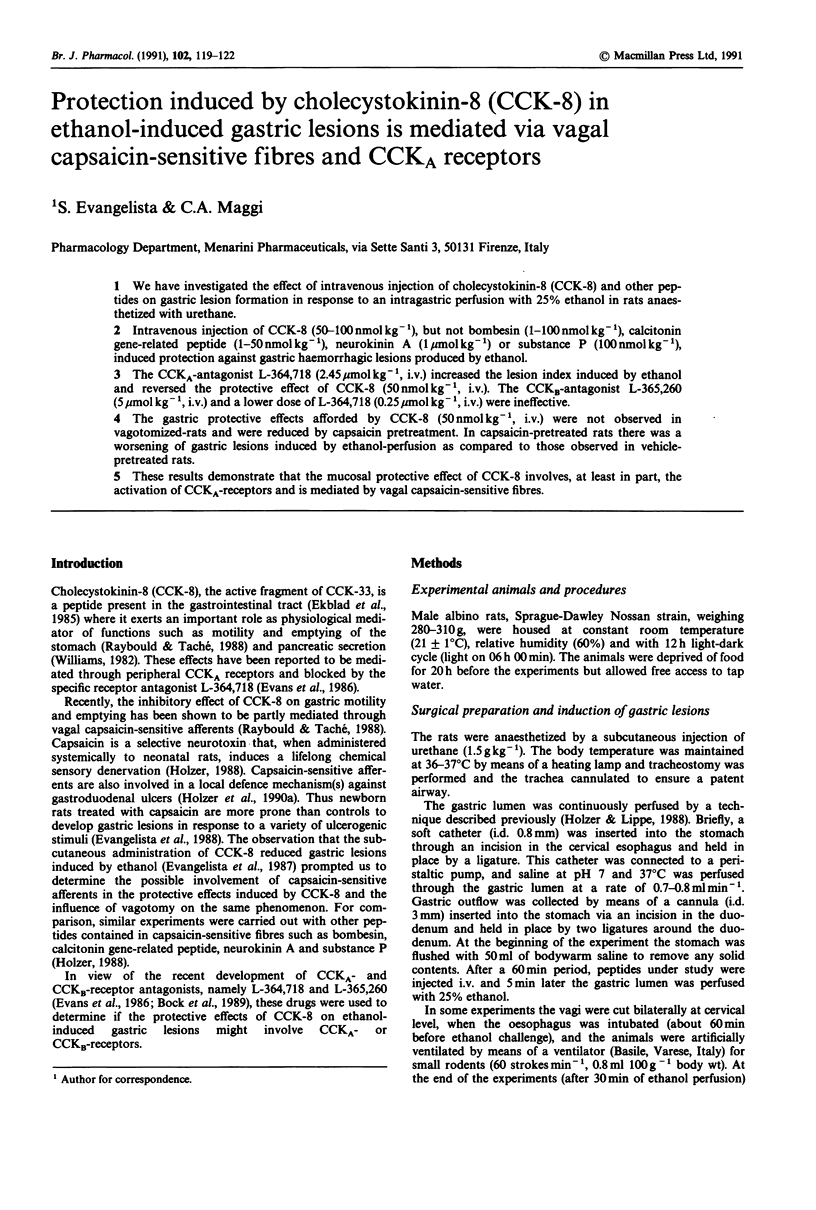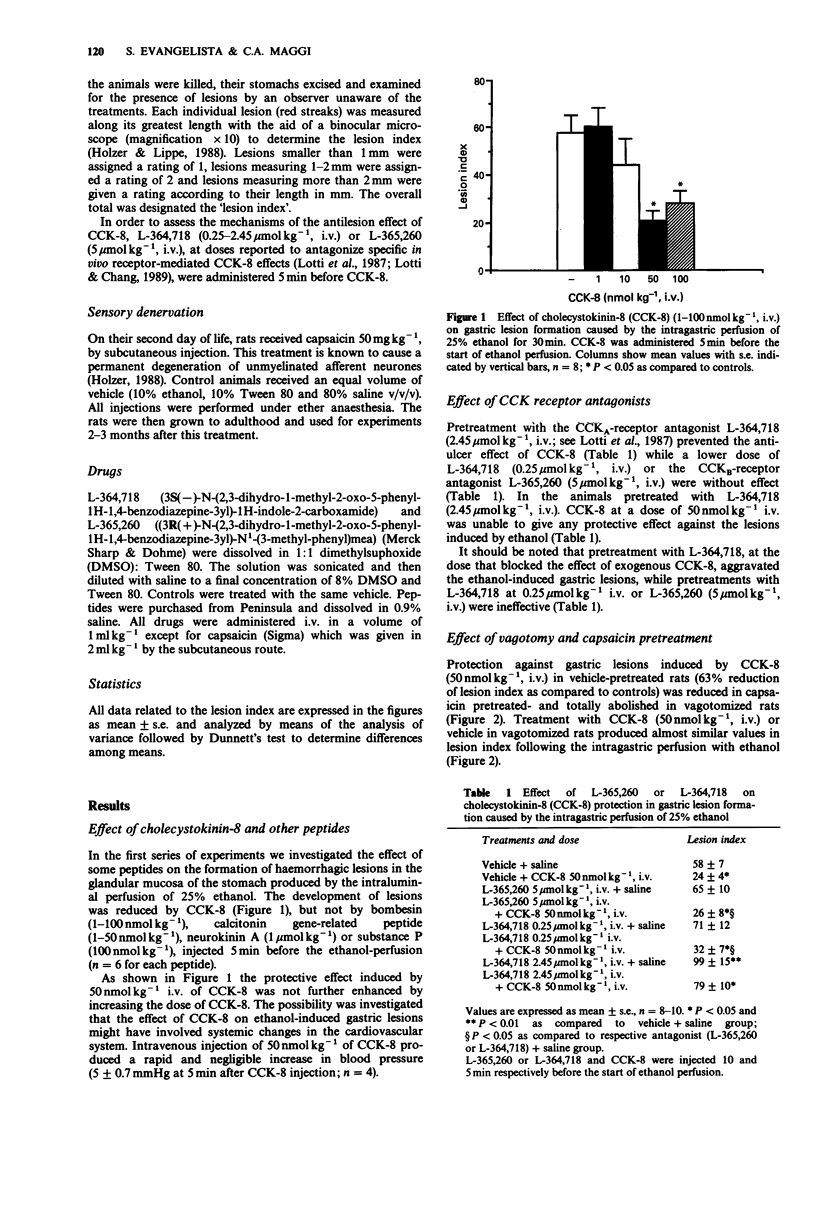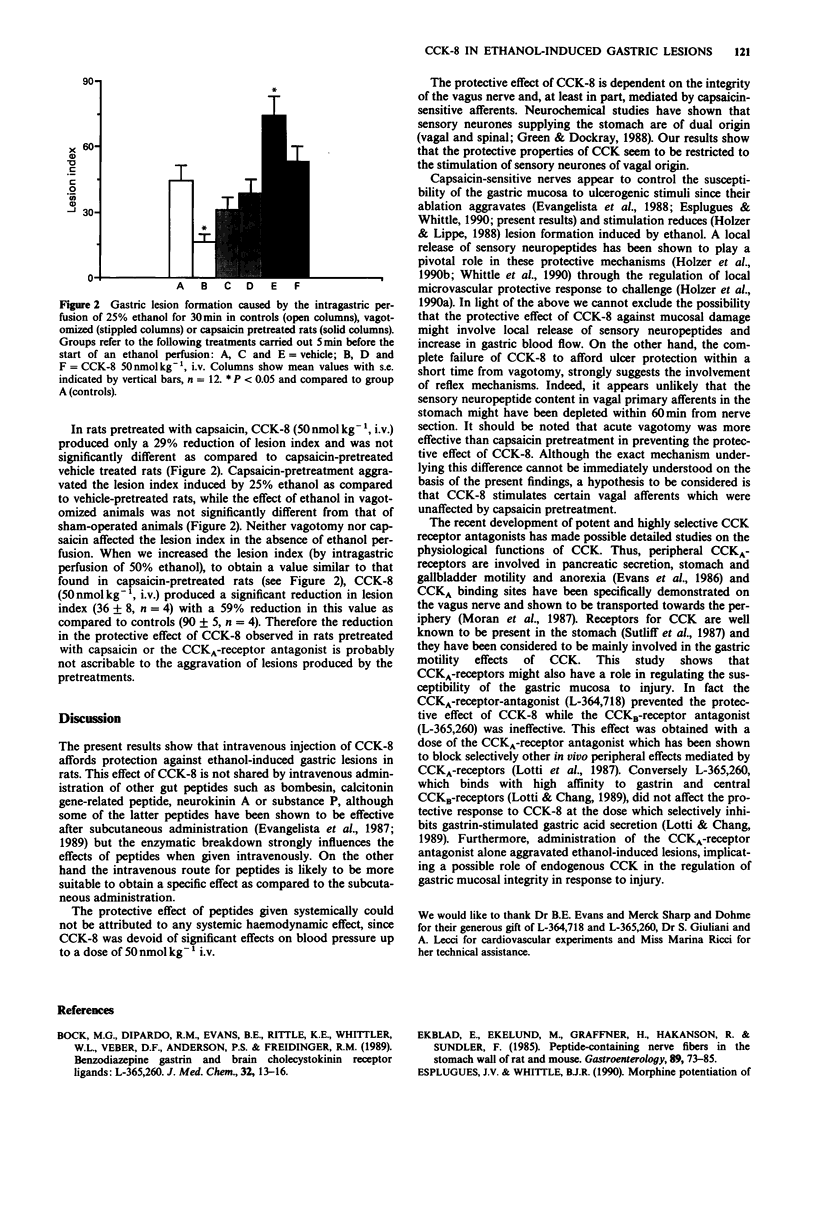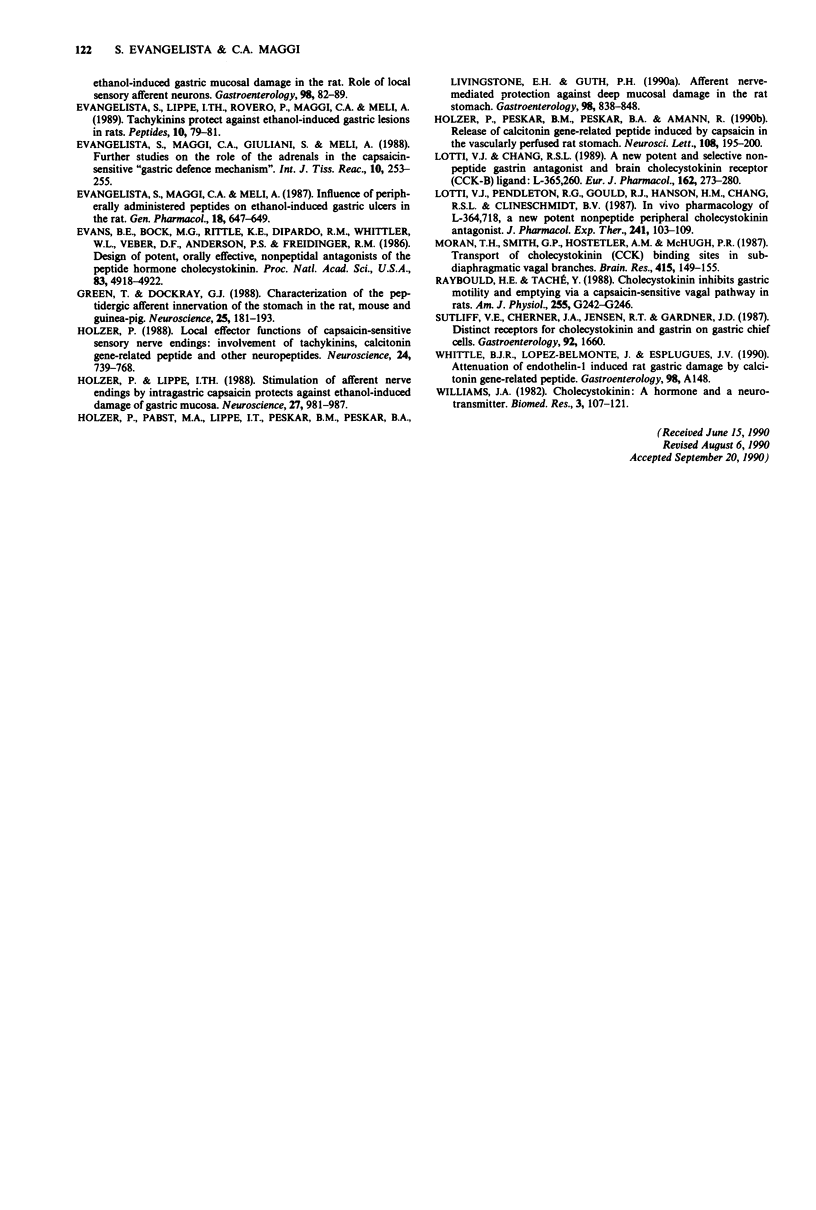Abstract
We have investigated the effect of intravenous injection of cholecystokinin-8 (CCK-8) and other peptides on gastric lesion formation in response to an intragastric perfusion with 25% ethanol in rats anaesthetized with urethane. 2. Intravenous injection of CCK-8 (50-100 nmol kg-1), but not bombesin (1-100 nmol kg-1), calcitonin gene-related peptide (1-50 nmol kg-1), neurokinin A (1 mumol kg-1) or substance P (100 nmol kg-1), induced protection against gastric haemorrhagic lesions produced by ethanol. 3. The CCKA-antagonist L-364,718 (2.45 mumol kg-1, i.v.) increased the lesion index induced by ethanol and reversed the protective effect of CCK-8 (50 nmol kg-1, i.v.). The CCKB-antagonist L-365,260 (5 mumol kg-1, i.v.) and a lower dose of L-364,718 (0.25 mumol kg-1, i.v.) were ineffective. 4. The gastric protective effects afforded by CCK-8 (50 nmol kg-1, i.v.) were not observed in vagotomized-rats and were reduced by capsaicin pretreatment. In capsaicin-pretreated rats there was a worsening of gastric lesions induced by ethanol-perfusion as compared to those observed in vehicle-pretreated rats. 5. These results demonstrate that the mucosal protective effect of CCK-8 involves, at least in part, the activation of CCKA-receptors and is mediated by vagal capsaicin-sensitive fibres.
Full text
PDF



Selected References
These references are in PubMed. This may not be the complete list of references from this article.
- Bock M. G., DiPardo R. M., Evans B. E., Rittle K. E., Whitter W. L., Veber D. E., Anderson P. S., Freidinger R. M. Benzodiazepine gastrin and brain cholecystokinin receptor ligands: L-365,260. J Med Chem. 1989 Jan;32(1):13–16. doi: 10.1021/jm00121a004. [DOI] [PubMed] [Google Scholar]
- Ekblad E., Ekelund M., Graffner H., Håkanson R., Sundler F. Peptide-containing nerve fibers in the stomach wall of rat and mouse. Gastroenterology. 1985 Jul;89(1):73–85. doi: 10.1016/0016-5085(85)90747-4. [DOI] [PubMed] [Google Scholar]
- Evangelista S., Lippe I. T., Rovero P., Maggi C. A., Meli A. Tachykinins protect against ethanol-induced gastric lesions in rats. Peptides. 1989 Jan-Feb;10(1):79–81. doi: 10.1016/0196-9781(89)90080-6. [DOI] [PubMed] [Google Scholar]
- Evangelista S., Maggi C. A., Giuliani S., Meli A. Further studies on the role of the adrenals in the capsaicin-sensitive "gastric defence mechanism". Int J Tissue React. 1988;10(4):253–255. [PubMed] [Google Scholar]
- Evangelista S., Maggi C. A., Meli A. Influence of peripherally-administered peptides on ethanol-induced gastric ulcers in the rat. Gen Pharmacol. 1987;18(6):647–649. doi: 10.1016/0306-3623(87)90039-5. [DOI] [PubMed] [Google Scholar]
- Evans B. E., Bock M. G., Rittle K. E., DiPardo R. M., Whitter W. L., Veber D. F., Anderson P. S., Freidinger R. M. Design of potent, orally effective, nonpeptidal antagonists of the peptide hormone cholecystokinin. Proc Natl Acad Sci U S A. 1986 Jul;83(13):4918–4922. doi: 10.1073/pnas.83.13.4918. [DOI] [PMC free article] [PubMed] [Google Scholar]
- Green T., Dockray G. J. Characterization of the peptidergic afferent innervation of the stomach in the rat, mouse and guinea-pig. Neuroscience. 1988 Apr;25(1):181–193. doi: 10.1016/0306-4522(88)90017-6. [DOI] [PubMed] [Google Scholar]
- Holzer P., Lippe I. T. Stimulation of afferent nerve endings by intragastric capsaicin protects against ethanol-induced damage of gastric mucosa. Neuroscience. 1988 Dec;27(3):981–987. doi: 10.1016/0306-4522(88)90201-1. [DOI] [PubMed] [Google Scholar]
- Holzer P. Local effector functions of capsaicin-sensitive sensory nerve endings: involvement of tachykinins, calcitonin gene-related peptide and other neuropeptides. Neuroscience. 1988 Mar;24(3):739–768. doi: 10.1016/0306-4522(88)90064-4. [DOI] [PubMed] [Google Scholar]
- Holzer P., Pabst M. A., Lippe I. T., Peskar B. M., Peskar B. A., Livingston E. H., Guth P. H. Afferent nerve-mediated protection against deep mucosal damage in the rat stomach. Gastroenterology. 1990 Apr;98(4):838–848. doi: 10.1016/0016-5085(90)90005-l. [DOI] [PubMed] [Google Scholar]
- Holzer P., Peskar B. M., Peskar B. A., Amann R. Release of calcitonin gene-related peptide induced by capsaicin in the vascularly perfused rat stomach. Neurosci Lett. 1990 Jan 1;108(1-2):195–200. doi: 10.1016/0304-3940(90)90730-w. [DOI] [PubMed] [Google Scholar]
- Lotti V. J., Chang R. S. A new potent and selective non-peptide gastrin antagonist and brain cholecystokinin receptor (CCK-B) ligand: L-365,260. Eur J Pharmacol. 1989 Mar 21;162(2):273–280. doi: 10.1016/0014-2999(89)90290-2. [DOI] [PubMed] [Google Scholar]
- Lotti V. J., Pendleton R. G., Gould R. J., Hanson H. M., Chang R. S., Clineschmidt B. V. In vivo pharmacology of L-364,718, a new potent nonpeptide peripheral cholecystokinin antagonist. J Pharmacol Exp Ther. 1987 Apr;241(1):103–109. [PubMed] [Google Scholar]
- Moran T. H., Smith G. P., Hostetler A. M., McHugh P. R. Transport of cholecystokinin (CCK) binding sites in subdiaphragmatic vagal branches. Brain Res. 1987 Jul 7;415(1):149–152. doi: 10.1016/0006-8993(87)90278-2. [DOI] [PubMed] [Google Scholar]
- Raybould H. E., Taché Y. Cholecystokinin inhibits gastric motility and emptying via a capsaicin-sensitive vagal pathway in rats. Am J Physiol. 1988 Aug;255(2 Pt 1):G242–G246. doi: 10.1152/ajpgi.1988.255.2.G242. [DOI] [PubMed] [Google Scholar]


